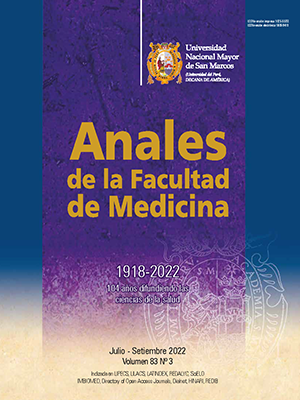Use of peripherally inserted central venous catheter in the Neonatal Intensive Care Unit of Instituto Nacional de Salud Del Niño Breña, 2017–2019
DOI:
https://doi.org/10.15381/anales.v83i3.22500Keywords:
Newborn, Neonatal Intensive Care, Indwelling Catheter, PeruAbstract
Introduction. Currently the birth rate worldwide is 18.8% and in Peru it is 10%. The main causes of neonatal mortality are preterm births, infections and congenital defects. The neonatal intensive care unit is the area that is responsible for the care of newborns in critical condition, obtaining an adequate central venous access route for their treatment is essential. Objective. To describe the use of the percutaneous peripheral insertion catheter in the Neonatal Intensive Care Unit of the Instituto Nacional de Salud del Niño Breña, period June 2017 - June 2019. Methods. The study was descriptive, observational, retrospective, cross-sectional. The intentional sample was made up of approximately 110 medical records of newborns who were hospitalized in the neonatal intensive care unit. The technique the observation and the instrument the checklist. Results. 51.8% were neonates with surgical pathology. Likewise, 36.4% had a gestational age less than or equal to 32 weeks, the most used vein was the basilica with 27.3%, 37.3% of the catheters were removed due to suspected Sepsis and the tips were sent for culture. Conclusions. The care in the procedure and maintenance of the percutaneous catheter was adequate, presenting a low number of complications.
Downloads
Published
Issue
Section
License
Copyright (c) 2022 Anales de la Facultad de Medicina

This work is licensed under a Creative Commons Attribution-NonCommercial-ShareAlike 4.0 International License.
Those authors who have publications with this magazine accept the following terms:
- Authors will retain their copyrights and guarantee the journal the right of first publication of their work, which will be simultaneously subject to Creative Commons Attribution License that allows third parties to share the work as long as its author and its first publication this magazine are indicated.
- Authors may adopt other non-exclusive licensing agreements for the distribution of the version of the published work (eg, deposit it in an institutional electronic file or publish it in a monographic volume) provided that the initial publication in this magazine is indicated.
- Authors are allowed and recommended to disseminate their work over the Internet (eg: in institutional telematic archives or on their website) before and during the submission process, which It can produce interesting exchanges and increase quotes from the published work. (See El efecto del acceso abierto ).















